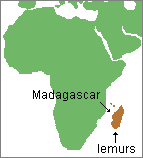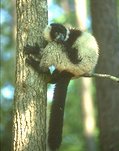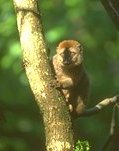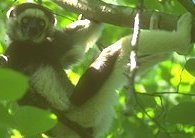Before you begin learning about
individual primate species, you may wish to download and print out the table
linked by the following button. This will help you grasp the
relationships of the different species and understand which ones are
evolutionarily close to us.
The order Primates
consists of two suborders: the Strepsirrhini
![]() and the
Haplorrhini
and the
Haplorrhini
![]() . The
strepsirhines
. The
strepsirhines
![]() all share the characteristic of having
a moist, largely hairless nose tip (rhinarium
all share the characteristic of having
a moist, largely hairless nose tip (rhinarium
![]() ).
This trait is shared with dogs, cats, and most other mammals that have a
good sense of smell. In contrast, the haplorrhines
).
This trait is shared with dogs, cats, and most other mammals that have a
good sense of smell. In contrast, the haplorrhines
![]() do not have wet nose tips. Other
anatomical traits distinguish these two primate suborders.
do not have wet nose tips. Other
anatomical traits distinguish these two primate suborders.
The strepsirhines were the first of the suborders to evolve.
Subsequently, they are often called the "lower primates." They
are also referred to as
prosimians
![]() which literally means "pre-monkey" in Latin.
When they were first given this name in the 19th century, it was only an
inspired guess that early prosimians evolved before the monkeys. It
was not until the mid 20th century that it was confirmed by the fossil
record.
which literally means "pre-monkey" in Latin.
When they were first given this name in the 19th century, it was only an
inspired guess that early prosimians evolved before the monkeys. It
was not until the mid 20th century that it was confirmed by the fossil
record.
The strepsirhines include the lemurs, lorises, and related animals. At one time they lived in most tropical regions of the earth, including North America. Today, they are found in the wild only in the Old World. The lemurs have the most restricted range, being found exclusively on the island of Madagascar and the nearby Comoro Islands, where they do not have to contend with competition from the more advanced non-human primates. It is likely that the first lemurs on the Comoro Islands were brought there by humans.
 |
|
 |
 |
||
| Ruffed black and white lemur | Red fronted lemur |
Lemurs reached Madagascar early in primate evolution and became isolated reproductively from the African mainland about 250 miles (402 km.) away. Subsequently, they evolved into the 22 or more mostly arboreal species of today. Elsewhere, they became extinct.
The name lemur comes from an ancient Latin word, lemures, which refers to frightening spirits of the dead who haunt people at nighttime. This curious reference comes from the fact that people in Madagascar commonly believed that lemurs were ghosts. This belief was supported by their observations of lemur behavior--many of the species are only active at night and make eerie sounds.
There are five surviving families of lemurs. Species of
the family Lemuridae
![]() , the
true lemurs
, the
true lemurs
![]() ,
range in size from that of a
small to a large domestic
cat. They have long bushy tails that are used for balancing as they jump
from branch to branch. They have a well-developed sense of smell
and often mark territorial limits with scent. They are
herbivorous in diet, mostly
eating fruit and some leaves.
The larger species, such as those shown in the
photos on the
right, are primarily diurnal
,
range in size from that of a
small to a large domestic
cat. They have long bushy tails that are used for balancing as they jump
from branch to branch. They have a well-developed sense of smell
and often mark territorial limits with scent. They are
herbivorous in diet, mostly
eating fruit and some leaves.
The larger species, such as those shown in the
photos on the
right, are primarily diurnal
![]() .
The true lemurs are unusually sociable for prosimians.
This is especially true of the ring-tailed lemurs, which form groups of up
to 25 individuals and spend almost as much time on the ground as in the
trees. Unlike most other primate species, lemur females generally
dominate males in their social interactions.
.
The true lemurs are unusually sociable for prosimians.
This is especially true of the ring-tailed lemurs, which form groups of up
to 25 individuals and spend almost as much time on the ground as in the
trees. Unlike most other primate species, lemur females generally
dominate males in their social interactions.
Ring-tailed lemurs--video clip from National Geographic Society
(length = 31 secs)
The family Cheirogaleidae consists of the smallest primate species, the dwarf and mouse lemurs. When full grown, some of them are only slightly larger than mice. They are nocturnal and relatively solitary. Their omnivorous diet consists mostly of fruit and easily obtainable animal prey such as insects, frogs, and baby birds in nests. They have large ears and very sensitive hearing, which is a valuable aid in hunting in the dark.
Capture of a mouse lemur--video clip from National Geographic Society
(length = 2 mins, 49 secs)
The family Indriidae
![]() includes three groups of species: indris
includes three groups of species: indris
![]() ,
avahis
,
avahis
![]() , and
sifakas
, and
sifakas
![]() . They are the most monkey-like of all of the
prosimians
in that they are relatively big. The indris are the largest in size,
reaching nearly four feet from head to toe
with their legs extended and weighing up to 21 pounds
(9.5 kg.). During the early evening, Indris proclaim their
territories in the tree tops with loud, piercing
vocalizations. By doing this, they
space themselves out in the forest. They are also distinctive in having only a vestigial
. They are the most monkey-like of all of the
prosimians
in that they are relatively big. The indris are the largest in size,
reaching nearly four feet from head to toe
with their legs extended and weighing up to 21 pounds
(9.5 kg.). During the early evening, Indris proclaim their
territories in the tree tops with loud, piercing
vocalizations. By doing this, they
space themselves out in the forest. They are also distinctive in having only a vestigial
![]() tail. The sifakas
have long spring-like legs that allow them to jump dramatically over 30 feet
(9 m.) from tree to
tree. This evolutionary specialization of their legs forces them to hop rather than
walk when on the ground.
tail. The sifakas
have long spring-like legs that allow them to jump dramatically over 30 feet
(9 m.) from tree to
tree. This evolutionary specialization of their legs forces them to hop rather than
walk when on the ground.
 |
|
||
| Sifaka |
 |
 |
||
| Aye-aye | Aye-aye hand |
The
extremely rare aye-aye
![]() is the only surviving species
of the family Daubentoniidae
is the only surviving species
of the family Daubentoniidae
![]() . They are
not often seen because they live solitary lives
mostly in forest trees, make little noise, and are nocturnal.
They have unusual hands and teeth for primates. Their
elongated, narrow
fingers have claw-like compressed nails that are used, along with their long,
curved, rodent-like incisor teeth, to get at grubs
under tree bark and other
hard to reach delicacies such as coconut meat. While they are primarily
carnivorous, their prey only includes such things as insects, eggs, and
newly hatched birds.
. They are
not often seen because they live solitary lives
mostly in forest trees, make little noise, and are nocturnal.
They have unusual hands and teeth for primates. Their
elongated, narrow
fingers have claw-like compressed nails that are used, along with their long,
curved, rodent-like incisor teeth, to get at grubs
under tree bark and other
hard to reach delicacies such as coconut meat. While they are primarily
carnivorous, their prey only includes such things as insects, eggs, and
newly hatched birds.
More than half of the lemur species are on the verge of extinction due to habitat destruction. Their forests in Madagascar have mostly been burned down by impoverished farmers seeking new farmland and wood to make charcoal for cooking. Lemurs are also commonly captured to be pets and killed to provide restaurant delicacies.